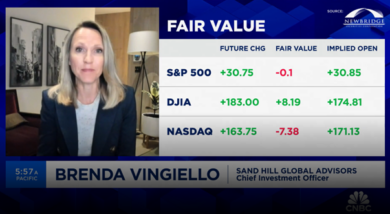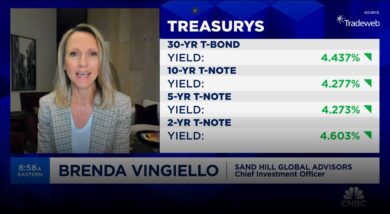Sand Hill's Chief Investment Officer, Brenda Vingiello, CFA, joins Jenny Harrington on “Halftime Report” to go over their most recent portfolio moves. Brenda's commentary begins

Money, Religion and Politics
These were the three topics most of us were raised to believe should never be a part of polite conversation, but with a hard fought and contentious presidential election campaign just weeks away from completion, such taboo subjects are inevitably top of mind for many investors. And while every presidential cycle tests our emotions, particularly those among us with strong political views, our overall analysis suggests that mixing politics and portfolios has proven to be a challenging recipe for investors.
Historically, presidential elections have only had a minimal impact on stock market performance and volatility. While this year’s stark contrast between the two major candidates is certainly relevant, election years still tend to be only slightly weaker for stock markets than non-election years, returning on average 6.5% since 1936, compared to 8.7% in all years since 1933. Furthermore, excluding the recent election years of 2000 and 2008, which occurred during periods of significant economic stress, the slight underperformance in election years almost disappears.
Given all the heated rhetoric at present, talk of an increasingly polarized population, and the ongoing impact of an insatiable 24-hour news environment, you might expect a market that is as jittery as much of the political climate seems to be. Instead, the S&P500 Index has actually risen over 6% this year and is currently trading near an all-time high. One way to interpret this is that investors have already priced in a continuation of the status quo, with the Democrats controlling the White House and the Republicans maintaining control of the House of Representatives – thus continuing the natural checks and balances that the American system is both famous for and often criticized. For now, such an outcome looks plausible, and is Sand Hill’s base case scenario.
Maintaining the status quo, while not without its challenges, offers the distinct advantage of being both a ‘known’ and, to some degree, analyzable. It is also important to remember that while the US presidency is considered the most powerful job in the world, there is little any president can do without congressional support. While many citizens may not like a divided government, the capital markets historically prefer such split governance. Indeed, this type of divided outcome should arguably matter just as much to investors as the headline-grabbing presidential contest since only the House of Representatives controls the ‘power of the purse’ and can introduce bills concerning changes to the tax system.
Interestingly, despite this cycle’s wider than typical polling differences, there remains more skepticism than usual due to poor polling projections this year in other important international contests, specifically the surprise Brexit vote by the United Kingdom to leave the European Union last June. This unexpected event and the subsequent market swoon reminded the world that polling, particularly when the issues are polarizing, can be wrong. So, how wrong can polling be and how do we think about that in our analysis?
Voting booths do remain the one place where individuals can pull the curtain behind them and independently vote their view, however unpopular or eccentric. The Brexit example taught us that polling in a polarized environment can be off by as much as 3-4% or more. Using this experience as a guide, current polling for our election is still indicating a margin of error in favor of maintaining the status quo, with the Democrats enjoying a 6% lead for the White House a week out from the election. This suggests to us that any possible Brexit-like margin of error in voting versus the forecasted polls would not result in a similar Brexit-like surprise or a material change in the Electoral College projections.
We do recognize this phenomenon is at play here, and believe that actual results will be closer than the polls currently suggest, especially if voter turnout is low. However, the magnitude of difference in the polling, as well as a deeper look at the contested elections for various seats in the House of Representatives, gives us confidence in our status quo base case.
Stepping back from the immediate term analysis, we would prefer to highlight an interesting statistical anomaly that emerges in inaugural years (the year after the election, when a new president is sworn in). Over the last eight presidential election cycles, inauguration years have typically seen exceptionally strong returns for the stock market, with an average gain of nearly 20%. Only in 2001, in the wake of the bursting of the Internet bubble, did the one year return end up negative. In part, this positive trend may be a function of stimulus leading up to elections or announced immediately thereafter, reduced uncertainty in general, or simply optimism (or acceptance) tied to the fresh start of a new four-year presidential term. Of course, we have no way of knowing what 2017 will bring, but it is noteworthy that over the last 30 years, elections (no matter what the outcome) have tended to ultimately be catalysts for stocks.
In the final analysis, we think the political environment the day after the election will look surprisingly similar to the one we have right now. In the wake of the election, investors will naturally turn their attention to the myriad of campaign promises that could impact the tax and estate planning landscape. Among some considerations put forth are a 28% cap on itemized deductions, a tax surcharge on high income earners, higher capital gains taxes for investments held less than five years, and a proposal to increase the estate tax rate while reducing the lifetime exemption to $3.5 million. A split government would mean either compromise or gridlock on most of these initiatives and many others.
Finally, while it’s a low probability, we cannot rule out the fact that this election year could turn out to be more volatile than the markets currently anticipate. Additionally, we are not suggesting that whoever occupies the Oval Office does not matter, or that there is a lack of potential market downside from any non-consensus election outcome. Should there be any post-election volatility we would likely see it as an opportunity for long-term investing, much like the Brexit vote led to fairly pronounced, but temporary, price declines that fell far short of the global economic calamity as some predicted.
All we are “politely” suggesting is that politics is but one of many factors that drive markets, and that there are reasons to be positive about the longer-term outlook from here, no matter your political persuasion. In the meantime, your Sand Hill team will be here to guide you through the final days of this election and assist you in examining the tax, estate and investment implications that will arise from the ultimate outcome of November 8th.
Articles and Commentary
Information provided in written articles are for informational purposes only and should not be considered investment advice. There is a risk of loss from investments in securities, including the risk of loss of principal. The information contained herein reflects Sand Hill Global Advisors' (“SHGA”) views as of the date of publication. Such views are subject to change at any time without notice due to changes in market or economic conditions and may not necessarily come to pass. SHGA does not provide tax or legal advice. To the extent that any material herein concerns tax or legal matters, such information is not intended to be solely relied upon nor used for the purpose of making tax and/or legal decisions without first seeking independent advice from a tax and/or legal professional. SHGA has obtained the information provided herein from various third party sources believed to be reliable but such information is not guaranteed. Certain links in this site connect to other websites maintained by third parties over whom SHGA has no control. SHGA makes no representations as to the accuracy or any other aspect of information contained in other Web Sites. Any forward looking statements or forecasts are based on assumptions and actual results are expected to vary from any such statements or forecasts. No reliance should be placed on any such statements or forecasts when making any investment decision. SHGA is not responsible for the consequences of any decisions or actions taken as a result of information provided in this presentation and does not warrant or guarantee the accuracy or completeness of this information. No part of this material may be (i) copied, photocopied, or duplicated in any form, by any means, or (ii) redistributed without the prior written consent of SHGA.
Video Presentations
All video presentations discuss certain investment products and/or securities and are being provided for informational purposes only, and should not be considered, and is not, investment, financial planning, tax or legal advice; nor is it a recommendation to buy or sell any securities. Investing in securities involves varying degrees of risk, and there can be no assurance that any specific investment will be profitable or suitable for a particular client’s financial situation or risk tolerance. Past performance is not a guarantee of future returns. Individual performance results will vary. The opinions expressed in the video reflect Sand Hill Global Advisor’s (“SHGA”) or Brenda Vingiello’s (as applicable) views as of the date of the video. Such views are subject to change at any point without notice. Any comments, opinions, or recommendations made by any host or other guest not affiliated with SHGA in this video do not necessarily reflect the views of SHGA, and non-SHGA persons appearing in this video do not fall under the supervisory purview of SHGA. You should not treat any opinion expressed by SHGA or Ms. Vingiello as a specific inducement to make a particular investment or follow a particular strategy, but only as an expression of general opinion. Nothing presented herein is or is intended to constitute investment advice, and no investment decision should be made based solely on any information provided on this video. There is a risk of loss from an investment in securities, including the risk of loss of principal. Neither SHGA nor Ms. Vingiello guarantees any specific outcome or profit. Any forward-looking statements or forecasts contained in the video are based on assumptions and actual results may vary from any such statements or forecasts. SHGA or one of its employees may have a position in the securities discussed and may purchase or sell such securities from time to time. Some of the information in this video has been obtained from third party sources. While SHGA believes such third-party information is reliable, SHGA does not guarantee its accuracy, timeliness or completeness. SHGA encourages you to consult with a professional financial advisor prior to making any investment decision.
Other Posts By This Author
- – A New Year’s Toast to the Silicon Valley Entrepreneur
- – How I Learned to Love the Bot
- – Thank You for Your Partnership
- – The Coming Deglobalization
Related Posts







